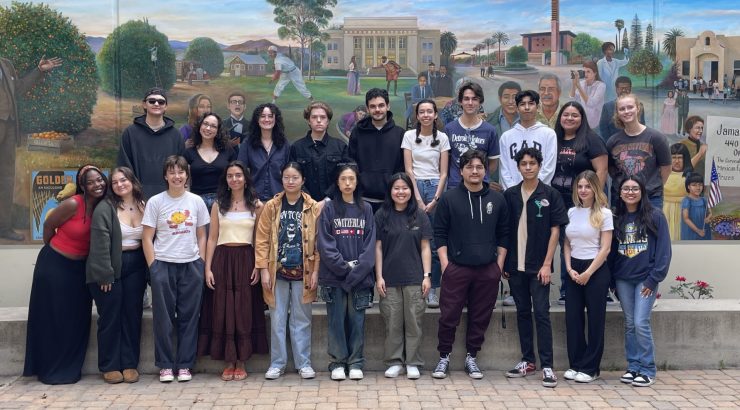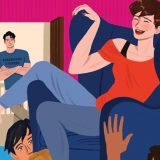
Art History Partners with Getty Research Institute
May 13, 2024
Seeking to understand the rich artistic cultures of the Mexica (Aztec) civilization in Tenochtitlán, Dr. Amy Buono’s Art History class ––The Arts of Tenochtitlán-Mexico City (AH 323) –– embarked on a semester-long journey through the Florentine Codex, a Nahua manuscript that records Indigenous history and knowledge of sixteenth-century central Mexico.
Researched for decades by Spanish Franciscan friar Bernardino de Sahagún and a team of Nahua scholars and artists, the codex was written between 1575-1577. The manuscript comprises 1,200 folio pages in Spanish and Nahuatl and 2,000 images as a third “narrative” in the manuscript. Dr. Buono’s class conducted research using the newly launched Digital Florentine Codex (DFC), a fully searchable, digital edition of the Florentine Codex developed by the Getty Research Institute in Los Angeles.
“Being able to work with Scalar and the Florentine Codex was a great experience that allowed me to not only understand more about the Nahua culture, but also the various tool at our disposal to analyze and interpret the Nahua culture and Nahuatl language in a new way,” said Matthew Garcia (‘25 Sociology major; Latinx and Latin American Studies minor).
“It is easy to say that coming in with a Mexican background [the Florentine Codex] felt heartwarming to read and see images that made just sense to me and my ancestral history. Researching on Nahua Woman I was able to obtain new information as to what roles women up took and seeing how natural herbal remedies my mom uses were just taken from the Nahua life,” said Andrea Onofre (‘26 Sociology major; Latinx and Latin American studies minor).
Students viewed manuscript text and image as visual instruments of imperial power in central Mexico and evangelism of Indigenous populations. The Florentine Codex transmitted a multi-directional flow of information, encoding tension and resistance as much as it inscribed Indigenous knowledge. In keeping with the codex as a team project, the group worked collaboratively to investigate the Nahua universe and world view. As interlocutors with this monumental artifact, students joined a conversation that started half a millennium earlier.
“Like solving a big jigsaw puzzle, but digitally. I found myself zooming in on details, looking for patterns in the tiled segments to help orient everything properly. Such a simple activity, but it drew me in and made me focus intently. While the coding aspect still feels complex, this activity made me appreciate IIIF’s power to open up cultural resources. Getting that level of access to zoom in on high-res details changes how I can study a work. I’d love to experiment by remixing different pieces into new digital exhibits or visualizations,” said Maggie Ge (‘24 Creative Producing major; Religion & the Arts minor).
The class partnered with the Getty Research Institute “FloCo” team, especially Senior Research Specialist Kim Richer, and UCLA faculty, Chien-Ling Liu Zeleny, Kevin Terraciano, and Charlene Villaseñor Black, and Lisa Sousa at Occidental College to develop and share online learning materials for undergraduate and graduate courses. Hands-on lab activities designed by Christopher Gilman, Digital Librarian at UCLA, developed student research proficiencies in annotation, detail analysis, and interpretive description, using original high resolution IIIF content from the Digital Florentine Codex site and other digital collections. The course culminated in group Scalar research projects on thematic topics about Nahua culture, including topics such as: The Flavors of Nahua Life; The Role of Birds; Healers and Healing Practices; Merchants and Traders; Celestial Objects; Nahua Women; and Nature and Animals.
“The scholars and researchers at the Getty Research Institute have done an incredible job bridging the gap between tradition and modernity in education. I’m looking forward to seeing the DFC’s development over time, and I hope it will be incorporated into more class curricula for others to enjoy,” said Julia Kelley (‘24 English major; Latinx and Latin American Studies minor).
“Our class is grateful for resources from across Chapman: a visit to Chapman’s Special Collections with librarian Lauren McDaniel and archives assistant Frank Lopez-Huerta to examine a translation of the Florentine Codex; an in-class workshop on Aztec glyphs with Art Studio Manager Lorena Ochoa; Scalar tutorials with Escalette Collection of Art Manager Jessica Bocinski, and a guest lecture with Nora Rivera on Chicanx muralism and the legacy of Mesoamerican visual forms,” said Dr. Buono.
Dr. Buono hopes this pilot class and collaboration with UCLA, and other institutions across the country will provide a useful template for similar courses in the future and also sees this as contributing to Chapman’s mission to become a Hispanic-Serving Institution (HSI).
(Pictured in header: Dr. Amy Buono’s spring Art History students in front of the Higgy Vazquez mural in the Moulton Hall entrance on Chapman campus).

